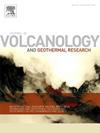Rootless littoral hydrovolcanic explosions and deposits, 6 April 2007, Piton de la Fournaise, La Réunion Island
IF 2.3
3区 地球科学
Q2 GEOSCIENCES, MULTIDISCIPLINARY
Journal of Volcanology and Geothermal Research
Pub Date : 2025-07-17
DOI:10.1016/j.jvolgeores.2025.108412
引用次数: 0
Abstract
The April 2007 basaltic eruption of Piton de la Fournaise began on 2 April at Piton Tremblet on the eastern flank of the volcano, 7 km from the summit. Vigorous fountains fed aphyric lavas that flowed another 3 km then entered the ocean. During the next few days, the olivine content of the lavas increased and by 5 April, the lavas were oceanite with ∼30 vol% olivine crystals. On 6 April, following a significant increase in lava discharge, spectacular hydrovolcanic explosions occurred where the lava in the main channel entered the ocean. Throughout the day, a sustained steam plume, vertical pyroclastic plumes, base surges and tephra jets were generated by the explosions. The products formed a nested littoral cone at the coast that was partly destroyed and almost entirely covered by subsequent lavas. Although lavas of oceanite composition continued to enter the ocean for the next 24 days, the hydrovolcanic explosions ceased after one day. One 7-m-thick exposure of the littoral cone studied in 2013 comprises bedded, poorly sorted combinations of glassy ash and vesicular lapilli and bombs. Three facies have been identified and interpreted to be deposits from base surges, fall and tephra jets. The explosive lava-water interaction coincided perfectly with a period of elevated discharge at Piton Tremblet on 6 April; the discharge rate subsequently declined. The Piton de la Fournaise 2007 littoral cone resembles historic ‘a‘ā-fed littoral cones on Hawaii. On Piton de la Fournaise, lava entering the ocean at high flow rate or following an increase in discharge ought to be considered potentially hazardous for rootless littoral hydrovolcanic explosions.
无根的沿海水火山爆发和沉积物,2007年4月6日,la r union岛Piton de la Fournaise
2007年4月,富尔奈斯峰的玄武岩喷发开始于4月2日,地点位于火山东侧,距离峰顶7公里。强劲的喷泉滋养着岩浆,岩浆又流了3公里,然后流入海洋。在接下来的几天里,熔岩的橄榄石含量增加,到4月5日,熔岩是海洋岩,橄榄石晶体约占30%。4月6日,随着熔岩排放量的显著增加,在主要通道的熔岩流入海洋的地方发生了壮观的火山爆发。一整天,持续的蒸汽羽流、垂直的火山碎屑羽流、底部涌流和火山喷流都是由爆炸产生的。这些产物在海岸形成了一个嵌套的滨海锥,部分被破坏,几乎完全被随后的熔岩覆盖。尽管在接下来的24天里,由海洋岩石组成的熔岩继续进入海洋,但火山喷发在一天后就停止了。2013年研究的一个7米厚的滨海锥暴露物包括层状的、分类不佳的玻璃状灰烬、水泡状的石柱和炸弹的组合。确定了三种相,并解释为基涌、落、喷流沉积。4月6日,火山喷发的熔岩-水相互作用正好与皮顿特雷布雷火山的高流量时期相吻合;放电率随后下降。Piton de la Fournaise 2007滨海锥类似于夏威夷历史上的“a”ā-fed滨海锥。在富尔奈斯峰,熔岩以高流速进入海洋或随着流量的增加而增加,应该被认为对无根的沿海水火山爆发有潜在的危险。
本文章由计算机程序翻译,如有差异,请以英文原文为准。
求助全文
约1分钟内获得全文
求助全文
来源期刊
CiteScore
5.90
自引率
13.80%
发文量
183
审稿时长
19.7 weeks
期刊介绍:
An international research journal with focus on volcanic and geothermal processes and their impact on the environment and society.
Submission of papers covering the following aspects of volcanology and geothermal research are encouraged:
(1) Geological aspects of volcanic systems: volcano stratigraphy, structure and tectonic influence; eruptive history; evolution of volcanic landforms; eruption style and progress; dispersal patterns of lava and ash; analysis of real-time eruption observations.
(2) Geochemical and petrological aspects of volcanic rocks: magma genesis and evolution; crystallization; volatile compositions, solubility, and degassing; volcanic petrography and textural analysis.
(3) Hydrology, geochemistry and measurement of volcanic and hydrothermal fluids: volcanic gas emissions; fumaroles and springs; crater lakes; hydrothermal mineralization.
(4) Geophysical aspects of volcanic systems: physical properties of volcanic rocks and magmas; heat flow studies; volcano seismology, geodesy and remote sensing.
(5) Computational modeling and experimental simulation of magmatic and hydrothermal processes: eruption dynamics; magma transport and storage; plume dynamics and ash dispersal; lava flow dynamics; hydrothermal fluid flow; thermodynamics of aqueous fluids and melts.
(6) Volcano hazard and risk research: hazard zonation methodology, development of forecasting tools; assessment techniques for vulnerability and impact.

 求助内容:
求助内容: 应助结果提醒方式:
应助结果提醒方式:


